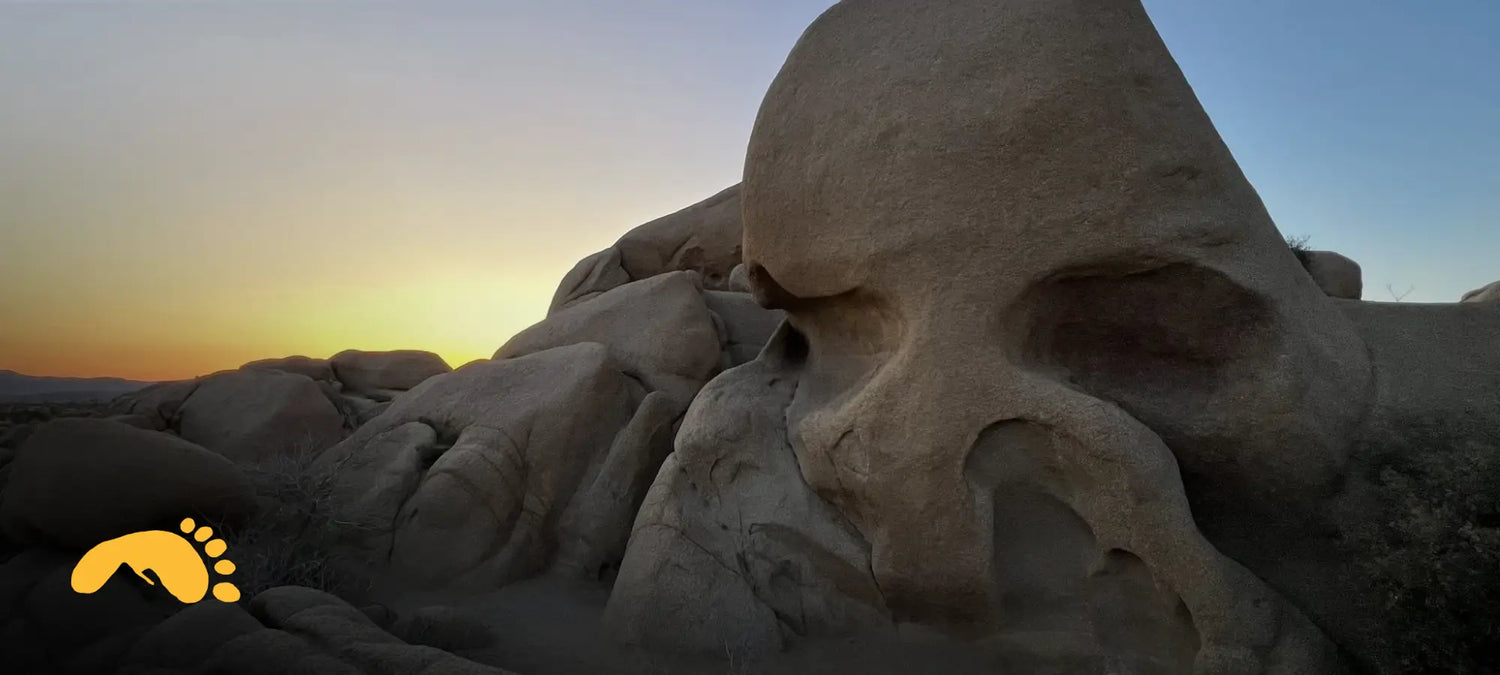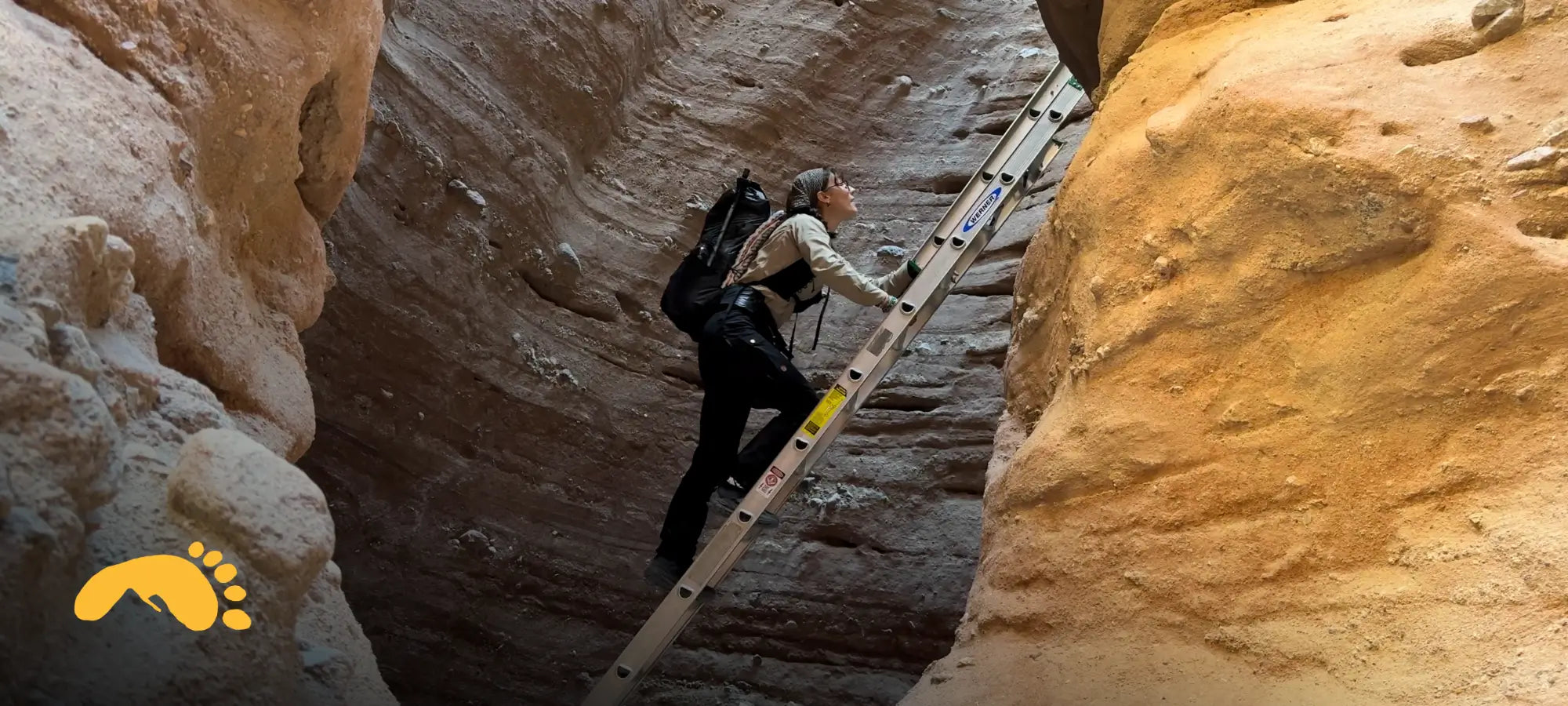The Ancient Guardian Sculpted by Nature: Skull Rock
If you've ever wandered through the desert and had the eerie sensation that you were being watched—you might be right. Among the weathered boulders of Joshua Tree National Park, one formation in particular has been keeping an eye (or two) on passersby for millions of years. Let's meet Skull Rock.

A wild Pepper, with her stick and microphone, crouches over a rock just in front of Skull Rock at Joshua Tree National Park.
Meet Skull Rock!
He's a massive, timeworn granite giant that looks… well, like a giant skull! But unlike your average Halloween decoration, Skull Rock wasn’t sculpted by human hands. Its formation is a story written in stone—a tale of ancient magma, slow but persistent erosion, and the relentless forces of nature.
85 Million Years in the Making
To appreciate Skull Rock, we need to rewind the clock— 85 to 150 million years , during the Mesozoic Era , when dinosaurs roamed and the Earth’s crust was in chaos. Magma rose from deep underground, but instead of erupting, it cooled beneath the surface , forming huge granite bodies called plutons (National Park Service, 2024). Over time, erosion slowly revealed them—creating the foundations of what we now know as Joshua Tree’s surreal rock landscape.
How Did Skull Rock Turn Into a Skull?
1. Chemical Weathering Begins the Sculpting Process
As granite became exposed, chemical weathering got to work. Slightly acidic rainwater reacted with feldspar minerals, breaking them down into kaolinite clay (Geology Science, 2024). Some areas eroded faster than others, leaving depressions that eventually formed Skull Rock’s iconic “eye sockets” (National Park Service, 2024).
2. Mechanical Weathering Widens the Features
Next up: mechanical weathering. Joshua Tree’s intense heat and cold cause rocks to expand and contract, producing stress fractures. Over time, these widened the cavities and deepened Skull Rock’s skeletal shape (Wildland Trekking, 2024).
3. Wind and Water Erosion Add the Final Touches
Wind-driven sandblasting smoothed the granite and enhanced its skull-like features. Occasional rainfall also dissolved minerals and carried sediment away, finishing off nature’s sculpture we have come to know as Skull Rock.
And Thus, Skull Rock Was Born!
After millions of years of underground formation, chemical breakdown, and surface erosion, Skull Rock took on its current haunting shape. And it’s still changing. One day, it may lose that familiar face altogether—but for now, it remains a sentinel of the desert.
An informational and fun little video on Skull Rock.
How to Hike to Skull Rock
Skull Rock is one of the most accessible and famous formations in Joshua Tree National Park, sitting just off the main road. You don’t have to be an experienced hiker to visit! It’s an easy walk from the parking area, making it a perfect stop for anyone wanting to marvel at nature’s handiwork (National Park Service, 2024).
Trail Info:
- Name: Skull Rock Nature Trail
- Distance: 1.7-mile (2.7 km) loop
- Time: ~1 hour
- Difficulty: Easy/moderate (some rocky terrain)
- Trailhead: Skull Rock Parking Area or Jumbo Rocks Campground
- Skull Rock Loop AllTrails Link
1. Start at the Skull Rock Parking Area
- The easiest way to access the trail is by parking at the Skull Rock parking lot on Park Boulevard.
- Alternatively, you can park at the Jumbo Rocks Campground and connect to the trail from there.
2. Follow the Clearly Marked Trail
- The trail is well-marked and relatively easy to follow. It’s mostly flat but has some rocky and uneven sections , so be mindful of your footing, but you can climb most of these rock formations as much as you’d like.
- Skull Rock itself is just a short walk from the road, making it a popular quick stop even for those not hiking the full loop.
3. Expect Crowds
- Because of its easy access and popularity, Skull Rock is almost always crowded, especially on weekends and during peak season (fall to spring).
- If you want photos without other hikers in the background, try visiting early in the morning or late in the afternoon.
4. Continue Along the Skull Rock Loop
- Beyond Skull Rock, the trail winds through a landscape of towering boulders and desert flora like yuccas and creosote bushes.
- Keep an eye out for small caves, narrow rock passages, and unique rock formations along the way.
5. Return to Your Starting Point
The full loop takes about an hour to complete, depending on how much time you spend exploring and taking photos.
Things to Know Before You Go
- No Cell Service: Download offline maps (AllTrails+ works great).If you’ve got the full version of AllTrails, you can download the map in advance, AND you can get a discount on AllTrails+ HERE!
- Wear Good Shoes: Grippy hiking shoes recommended.
- Bring Plenty of Water: Even for short hikes—this is the desert.
- Watch for Wildlife: Lizards, jackrabbits, and maybe even bighorn sheep.
- Best Time to Visit: Mornings or evenings. Midday is often hot and crowded.
Skull Rock is one of my personal favorite landmarks in Joshua Tree National Park. I'd recommend giving yourself lots of time to take in the beauty of the other rock formations that neighbor Skull Rock, as they are just as interesting, and certainly fun to explore. The entire area surrounding Skull Rock really does feel like a different planet. So if you get the chance, get exploring!
References
- Geology Science. (2024). Skull Rocks: Geology, formation. Retrieved from https://geologyscience.com/gallery/geological-wonders/skull-rocks/
- National Park Service. (2024). Geologic formations in Joshua Tree National Park. U.S. Department of the Interior. Retrieved from https://www.nps.gov/jotr/learn/nature/geologicformations.htm
- National Park Service. (2024). Skull Rock. U.S. Department of the Interior. Retrieved from https://www.nps.gov/places/skull-rock.htm
- Wildland Trekking. (2024). Origins of a mystery: Joshua Tree’s rock formations. Retrieved from https://wildlandtrekking.com/blog/origins-of-a-mystery-joshua-trees-rock-formations/

Follow in My Footsteps!
Patreon
If you want exclusive content, behind-the-scenes chaos, and a cozy little supporter-only space, Patreon is where it’s at. It’s like the VIP lounge of Pepper Steps, but with fewer velvet ropes and more lichen facts. You can join for free, so come and hang out!
YouTube
This is my personal favorite spot to be. From functional fitness to educational backpacking vlogs and all of the dorkiness under the sun, I've got something here for you. Grab your favorite trail snacks and stay awhile!
Discord
Wanna chitchat with me? How about thousands of other nature loving friends? From gear talk, to fitness, to backpacking, and heck, even League of Legends (Pepper's favorite video game), there's a whole darn community waiting for you to say hello! What are you waiting for?!
Pep Talks
Need one-on-one advice on social media, hiking, gear, or content creation? Book a Pep Talk with me, and I’ll help you figure it all out. No gatekeeping here my friend, just real advice from someone who’s been there.
See You on the Trail!
Thanks for being here, for supporting this wild journey, and for being part of the coolest little corner of the internet. Whether you're here to laugh at my backpacking mishaps, geek out over plants, or plan your next big adventure, I’m so stoked to have you along for the ride.
HAPPY STEPPIN'!
Pepper 👣






Leave a comment
This site is protected by hCaptcha and the hCaptcha Privacy Policy and Terms of Service apply.